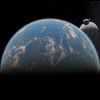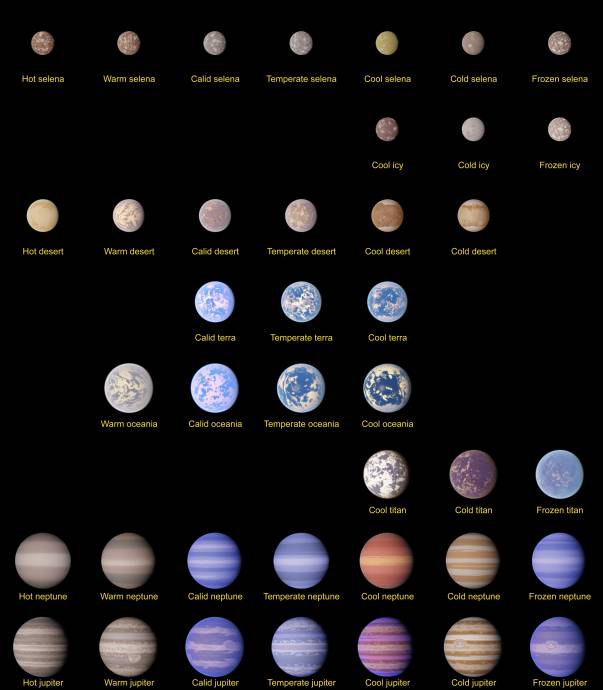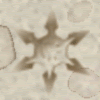|
SpaceEngine Planet Classifications
|
|
| SpaceEngineer | Date: Wednesday, 08.06.2011, 19:12 | Message # 1 |
 Author of Space Engine
Group: Administrators
 Russian Federation
Russian Federation
Messages: 4800
Status: Offline
| Hello all,
Here I shall to describe the classification for all planets in SpaceEngine, and I would like to have suggestions from you on how to improve those classifications.
Here are the picture screenshots of all types of planets from SpaceEngine. The size of all planets have been made the same, because these screenshots were made by the 'G' autopilot end-point. Of course all the planets have different sizes really. Classification is shown two-dimensional: 'Class' is vertical, and 'temperature' is horizontal.
Click opens a full-res image
Version 0.93

Version 0.95

All planets are divided into two big categories - gas giants and small "solid" planets (with solid surface). The gas giants in modern planetology are divided into two categories - normal gas giants like Jupiter and Saturn, which has a lot of hydrogen and helium, >90% of planetary mass, and "ice giants" like Uranus and Neptune, which has a lot of various "ices" - water, ammonia, etc. Hydrogen and helium constitutes only about 10-20% of planetary mass. Such planets are named "ice giants" because water and ammonia are in solid form under immense pressure in the planetary interior. Usually ice giants are smaller than gas giants, and very low-mass ice giants tends to be an "ice world" with my classifications (see below).
I divided solid planets into 4 categories. "Selena" is a rocky planet without atmosphere (example: Moon, Mercury). "Desert" is a rocky planet with an atmosphere (Venus, Mars). "Terra" is a rocky terrestrial planet, with an atmosphere and liquid water on the surface (the Earth  ). "Ice World" or "Waterworld" are planets containing a lot of water, in the form of a global ocean or in the form of an icy crust (Europa, Ganymede), depending on their temperatures. Immediately it is apparent that the latter class must be divided into two - with atmosphere ("Titan") or without atmosphere ("Icy"). Deserts may also contain water, but in the form of ice (= "Cold Terra"?) - it has not yet been taken into account in my classification. And Terras - those are actually a kind of intermediate class between deserts and water / ice planets. ). "Ice World" or "Waterworld" are planets containing a lot of water, in the form of a global ocean or in the form of an icy crust (Europa, Ganymede), depending on their temperatures. Immediately it is apparent that the latter class must be divided into two - with atmosphere ("Titan") or without atmosphere ("Icy"). Deserts may also contain water, but in the form of ice (= "Cold Terra"?) - it has not yet been taken into account in my classification. And Terras - those are actually a kind of intermediate class between deserts and water / ice planets.
A question to those of you interested in this: How could I improve or alter these classification? Perhaps offer to separate some of the global parameters - the presence of an atmosphere, the presence of water on the surface. What then would be the best classification for not using the surface, but the entire crust of the planet - its ratio of water to silicates content? Plus, there may be other types of hydrosphere - methane, ethane, ammonia, etc. Somewhere may exist hot molten planets covered by seas of lava. And then there's carbon, iron and other exotic planets...
Next, all planets have a temperature class, given by the average surface temperature (currently SpaceEngine does not support temperature variations on the surface):
> 800K = > +527C - Hot (generally accepted scientific term)
400...800K = +127...+527C - Very warm (warm)
300...400K = +27...+127C - Warm (Calid)
250...300K = -23...+27C - Comfort (Temperate)
200...250K = -73...-23C - Cool
100...200K = -173...-73C - Cold
< 100K = < -173C - Very cold (Frozen)
Is this temperature classification normally used in English?  Maybe it's better to rename "very cold" to "frozen", but then, how would we rename "very warm" ? Maybe it's better to rename "very cold" to "frozen", but then, how would we rename "very warm" ?
In accordance with such naming it would be very strange to hear the phrase "hot ice giant". How else could we name the ice giants? Is it better to rename "ice giants" to "neptunes", and "gas giants" to "jupiters", and so forth? Also, I do not like the name "ice / water world." Water world can be called "oceanides" like in Russian. And what can we call ice planets? By analogy with "neptunes" / "jupiter" it could be "ganymedes" (without an atmosphere) and "titans" (with an atmosphere)? Then, should deserts be called "mars" or "venus"? Does anyone have some more constructive suggestions here? 
*

|
| |
| |
| DevonX | Date: Wednesday, 08.06.2011, 23:42 | Message # 2 |
 Space Pilot
Group: Users
 Norway
Norway
Messages: 113
Status: Offline
| I like the name of the planets like it is now. But there could be more planet types like a own class if the planet has lava streams or is 100% magma. It would also be nice to have some more info of the planets like tilt, water % lava %if its a lava planet and maybe a custom clock displaying the current time of your location on the planet or something would also be cool. More content and more variation on the planet types. I cant wait on what you are going to do with space engine and how its going to look when done. Keep up the good work. 
|
| |
| |
| Neon | Date: Friday, 10.06.2011, 08:01 | Message # 3 |
|
Explorer
Group: SE team
 Australia
Australia
Messages: 208
Status: Offline
| Well, we definitely need Io, Titan and Venus class planets.
The other thing to think about is atmosphere types. However,
I think the best form (for a game environment) is the current
system, as you need no prior knowledge to recognise a planet
type (ie Warm Comfort Terra with Life) pretty clear.
That said, here is a link to a whole range of different classes
which is based more on planet evolution.
Planet Evolutionary Classes letter system
I don't think a letter system is appropriate in SE for the above reason,
it was more aimed at realism, then it'd probably be closer to what planetologists
will eventually come up with.
I would however change the Selena class (though it is a nice name), it
provides no information, it also seems very similar to the desert class.
I guess the best system is based around what you've currently done:
Surface Type, Temperature type n maybe add Atmosphere, n possibly
Molten core or not (implying magnetic field (--- ooo Auroras :)).
However the hard part with that is how to say it all in one line.
Then there's one planet type that definitely should be in SE when protostars
are available, and that is protoplanets, including all the debris crashing into
them. How much of that is possible I don't know. Be gorgeous though.
I really don't like the idea of using our planet types as a naming system, ie Jupiters etc.
Except maybe with Earth like worlds. Using our planet types does have meriet simply
as we are all so familiar with them, but it'd get boring quick going from star to star
n seeing the same names popping up. I'd prefer something a little more scientific
but not requiring prior knowledge (as in the Letter system ie Class M - that's just
too vague for the average user who might not know the system. He might miss
an interesting planet simply because he doesn't know what type it is.
This is why I do like the current system, as it's so clear, you know what to
expect, but still know you can be surprised. 
Pure volcanic hot lava worlds (ie sci fi type) would really only exist in RL
in Protostars, where they are being constantly bombarded, so I'd leave those
only for those types.
I guess the only big improvement would be atmosphere types n with or
without a magniet field (remember if you are close to a star or a hot jupiter
and you want to spend time on a rocky planet near there, you'll need one with
a good magnetic field to protect you from the radiation. This type of thinking
would be great for the game, as it expresses just how dangerous space can be.
Titan class planets rich in organic with Methane lakes n atmosphere would be
interesting places, and from a gaming point of view, a good place to mine
for Organic Chemicals & flamable gasses. Io, would be great for Sulpurs
and other rich minerals found in and near volcanoes.
Well, I think that's about it for now... if I think of something else I'll dump
it in here. 
|
| |
| |
| Neon | Date: Friday, 10.06.2011, 08:04 | Message # 4 |
|
Explorer
Group: SE team
 Australia
Australia
Messages: 208
Status: Offline
| I like Devons ideas, especially knowning the Calendar and rotation information.
Maybe an option eventually in ship, would be to open a panel or display
detailed planetary information (preferably on a screen in cockpit).
The hard part of this, is since it's procedural programming, how you make it
work for all the massive numbers of objects out there.
|
| |
| |
| DevonX | Date: Friday, 10.06.2011, 13:39 | Message # 5 |
 Space Pilot
Group: Users
 Norway
Norway
Messages: 113
Status: Offline
| Quote (Neon) I really don't like the idea of using our planet types as a naming system, ie Jupiters etc.
I totally agree with you on that point. naming planet types like that would only make it more confusing as it is the planet names and not the type. As for the lava planets and their existence, that really depends on how young the planet is. Remember that once opp on a time earth was a lava world. The universe is big, bigger than what we can explore. I am sure of that there is more types of planets out there that we even cant imagine how looks and acts like. With that told, i have not problems if you add planet types that "don't" exist as there is a possibility that it might do. You never know.
|
| |
| |
| Neon | Date: Friday, 10.06.2011, 17:20 | Message # 6 |
|
Explorer
Group: SE team
 Australia
Australia
Messages: 208
Status: Offline
| Yeh that's true Devon, such as planets with Chlorine or Fluride atmospheres.
Probably don't exist but it's posssible. I saw a thread somewhere through google
that discussed how such planets might work, but it's purely speculation of course.
I prefer planet types that seem the most likely, but I'd love to find the odd
real surprise out there. I'd like to see some worlds that are out of the box,
espcecially if it's within the realm of science.
Yes I do realise lava planets are really only an option in very young
planets, as I said as in protoplanets during bombardment. Would love
to see that. I have dreams of visiting the Orion Nebula and exploring
the new worlds forming there. Will never happen, but it'd be fantastic to see.
|
| |
| |
| Tzion | Date: Friday, 10.06.2011, 20:50 | Message # 7 |
 Observer
Group: Newbies
 United States
United States
Messages: 8
Status: Offline
| I'd like to suggest replacing the "Comfort" temperature label with "Temperate". "Comfort" seems to suggest more attributes than just a habitable temperature range. It would, however, be appropriate to use it as an additional label for planets that fit the Goldilocks zone requirements (temperature, moisture, gravity). Rather anthropocentric, though.
|
| |
| |
| Thurs | Date: Tuesday, 14.06.2011, 10:59 | Message # 8 |
 Astronaut
Group: Users
 United States
United States
Messages: 49
Status: Offline
| I heard that you were fairly inspired by Noctis, which is amazing. If you remember, some of the celestial bodies were incredibly unique, with vibrantly-colored skies, oceans, strange terrain, etc. Obviously, this is fairly unrealistic for a fairly accurate galactic modelling program. However, knowing procedural generation, it would not be too hard to enforce limits on color, terrain, etc. generation to keep too extreme of values from being used.
What if there was an option to increase the limits on variations in the procedural fractals and algorithms, such as that higher values may create planets with, in more extreme cases, pink spires and mesas rising from a rich green sea?
Already, there is a great deal of variation between generated planets, and it looks realistic. But part of the interest of Noctis was the incredibly alien landscapes you would occasionally stumble across. It doesn't really matter though, this is just a whimsical little suggestion, and it's already pretty amazing the way it is.
Edited by Thurs - Tuesday, 14.06.2011, 11:00 |
| |
| |
| Neon | Date: Tuesday, 14.06.2011, 18:05 | Message # 9 |
|
Explorer
Group: SE team
 Australia
Australia
Messages: 208
Status: Offline
| I think I might do a back flip and change my mind on the naming system
of planets. Really, we use a the accepted letter system for star classification,
why not use the same system for planets. Anyone into a space program like
this is probably going to want to know it.
I like Tzions idea of changing comfort to temperate, I think he's dead right
there, it does imply more information than just temperature.
I also really like Thurs idea of rare strange alien highly colourful & artistic
worlds. The universe & galaxy are so big, we can easily afford to have say
10% stars have exotic & strange alien worlds, as he suggests. I'd love to
stumble upon one. Much like in Hitchikers guide when they were picked up
by the improbability drive, and saw images of an azure sea with pink sky.
The other thing I really do not like, is the colours of planets all seem wrong.
Io for example is way too neutral a tone. The real planet has intense colours.
Most of the planets I've seen the colour just never seems right. I really
think they could all do with some more saturation. Easy thing to do in photoshop
on the base planet maps.
|
| |
| |
| Dwarden | Date: Sunday, 31.07.2011, 00:14 | Message # 10 |
 Astronaut
Group: SE team
 Czech Republic
Czech Republic
Messages: 63
Status: Offline
| i would definitely like atmosphere types as it can be later used for other stuff
Ideas are like ocean w/o borders! https://twitter.com/FoltynD
|
| |
| |
| BlackArk | Date: Sunday, 31.07.2011, 00:14 | Message # 11 |
|
Space Pilot
Group: Users
 United States
United States
Messages: 137
Status: Offline
| Planet type
Terra - worlds- a body that's 0.4 - 10.0 the mass of earth terra worlds can have large amount of water or stater amount of water on it's surface terra worlds can positble have life or a barren wast land.
Barren - Barren worlds is a Hot or cold dry wast land that have little no water on it's surface barren worlds can have Heavy amount of meital and ore. do it's thin atmosphere it can have heavy bombardment by asteroids and comets.
Gasgiant - Gasgiant worlds or the Biggest planets 11 times the mass of earth or more. Gasgiant worlds have No surface do to the mass of the planet they have Massive mount of gas that can be use for fuel for advanced Civilization.
City worlds- City worlds is a world that cover by city's all over the world these are build by a super advanced Civilization that can use space flight City worlds can house's billion or tillrion or ailens's or people. they don't have alot of recourse on the planet's surface.
Ice worlds- They are the frozen wast land that can go down to 38 - -340* ice worlds have large amount of water ice or other type's or ice's on it's surface.
Carbon worlds - Carbon worlds are rear to find and have rich carbon recourse's it can be mined for carbon crystals and other recourse. 
Added (04.08.2011, 15:51)
---------------------------------------------
Rear planet type
Dark matter worlds- Dark matter worlds are vary Unknown they can go up to 12 times the mass of the earth or higher Dark matter worlds have no known facts on how they form.
Iron worlds - Iron worlds are planets that is cover by Iron or other ore this will be great for mining Civilization that use heavy amount of Iron. 89% or more is Cover by Iron on the planet's surface.
Dark energy worlds- Dark energy worlds is vary Unknown just like Dark matter worlds there are No known facts on how they form.
negative matter worlds- negative matter worlds are werid worlds that have anti gravity property this anti gravity ore can be use for flying cars and ships. there is No known facts on how they form.
|
| |
| |
| SpaceEngineer | Date: Thursday, 04.08.2011, 13:44 | Message # 12 |
 Author of Space Engine
Group: Administrators
 Russian Federation
Russian Federation
Messages: 4800
Status: Offline
| BlackArk
A city world is unnecessary. Cities are a thin film covering the planet. Advanced civilizations can mine resources not only from the surface of a planet, but from deep inside the interior too, at thousands of kilometers deep. They have access to the melted mantle and iron core. So in the game the player will have an interest on internal composition of planet as well. and not just the surface.
Dark matter worlds, Dark energy worlds and negative matter worlds are impossible. Modern physics says that dark matter are non-baryonic particles, i.e. it's not atoms. It can't form a rigid or gas body like a planet or star. Dark energy is not matter at all, it is the property of space-time. Negative mass matter does not exist in nature, but even if it did, it obviously can't form a planet due to anti-gravity, that would prevent accretion.
So, your classification becomes this:
Iron
Terra
Barren
Carbon
Ice
Gasgiant
*

|
| |
| |
| BlackArk | Date: Thursday, 11.08.2011, 11:41 | Message # 13 |
|
Space Pilot
Group: Users
 United States
United States
Messages: 137
Status: Offline
| cool thanks  Added (04.08.2011, 16:48)
---------------------------------------------
SpaceEngineer, is there there going to be new planet type or texures? Added (11.08.2011, 14:41)
---------------------------------------------
Full type of Planets: MesoPlanet, Small Terrestrial, Geoactive, Super Terrestrial, Desert, Gas Supergiant, Gas giant, Gas Ultragiant, Marginal, Terrestrial , Reducing , Oceanic , Glaciated, Ultra Hostile , Brown Dwarf: Brown Dwarf is Not A Planet but I just add it in :): Dirty Snowball , Ice World. these are New classification for planets 
|
| |
| |
| SpaceEngineer | Date: Tuesday, 06.09.2011, 18:56 | Message # 14 |
 Author of Space Engine
Group: Administrators
 Russian Federation
Russian Federation
Messages: 4800
Status: Offline
| So, back to the classifications I would like to have:
1) Replace "temperature-class words" to these:
Code
Hot -> Hot (+527C...+1800C)
Very warm -> Warm (+127...+527C)
Warm -> Calid (+27...+127C)
Comfort -> Temperate (-23...+27C)
Cool -> Cool (-73...-23C)
Cold -> Cold (-173...-73C)
Very cold -> Cryogenic (-273...-173C)
I think one word description will be better. Are these words correct and sound right in English? Or should I replace "Warm" to "Fiery" or "Warmish," and "Calid" to "Warm"? Or replace "Cryogenic" to "Frozen" and so forth?
2) Add ocean planets and name its class to "Oceania" or "Oceanid". For example: "Temperate oceania with life". Is this a good English name too? I chose that because it is analog to Russian term "Oceanida".
3) Add new class for frozen icy planets with and without atmospheres. But I have an idea on how to name them. An Icy planets with an atmosphere is like Saturn's satellite Titan - It can have liquid hydrocarbons on its surface and thus is similar to terra class planets. Some Icy planets with atmospheres can be covered by hydrocarbons entirely, and thus look like oceania class planets. Some of then can be "dry" ice deserts, similar to desert class planets. And finally, icy planets without atmospheres are similar to Ganymede and look like selena class planets - with heavy cratered surface. For now, all these 4 classes are named "Ice world" in SpaceEngine, but I want to introduce some variety and give individual names to each class. For example, "Titania", "Ganymedia" and so on. There is a fifth class too, that has no analogs of rocky planets: Europa like planets that have a cracked icy surface and a water ocean underneath it. It, too, needs a class name.
The difference between rocky and icy planets is that they can be presented as solid terrestrial planets covered with an ice crust and probably have a melted ice mantle (water) underneath it. So all of them are simply frozen ocean planets. But some of the icy planets can have their own "hydrosphere" of hydrocarbons.
Maybe it is possible to form a class name for the upper parts that could represent structure of planet:
rock = "selena"
rock + atmo = "desert" or "barren"
rock + water + atmo = "terra" or "oceania"
rock + water + ice = "europa" or "ganymede"
rock + water + ice + atmo = "?"
rock + water + ice + hydrocarbons + atmo = "titan"
iron + rock = "selena" or "mercury"
iron + rock + atmo = "desert" or "barren"
...
ice = "mimas"
ice + atmo = "?"
ice + hydrocarbons + atmo = "titan"
...
As you can see, some structural classes give the same visual appearance of a planet, for example, presence or absence of iron core does not affect surface, hydrosphere and atmosphere, it determines only the density of a planet.
*

|
| |
| |
| gpaw5765 | Date: Tuesday, 06.09.2011, 22:20 | Message # 15 |
 Astronaut
Group: Users
 Spain
Spain
Messages: 40
Status: Offline
| I'm not a native english-speaker, but my here's my opinion about these changes
1) Changing "comfort" to "temperate" is good, but changing "very cold" to "cryogenic" sounds very strange to me. I think it would be better to leave it as "very cold", or perhaps "frozen". Changing "warm" to "calid" is OK.
2) For ocean planets I would use the term "ocean planet" (yes, I like being original). The current term "water world" is also OK. If you want to use a single world, I think "oceanid" sounds better than "oceania", but this is a matter of personal taste.
3) Why not just use "cold selena", "cold desert" and "cold terra"? Aren't the icy planets you propose just colder versions of already existing planet classes?
Check my Space Flight Simulator for Android!
|
| |
| |